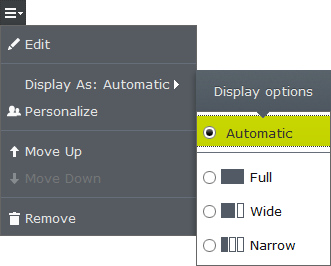Display options
Describes how to specify which render templates are available for selection in the user interface.
When working with content in a content area in Optimizely Content Management System (CMS 11), editors often like to specifically choose how to lay out the content, choosing which rendering template should display each item. Display options let developers specify which render templates are available for selection in the user interface.
Configure display options
You can make rendering templates available for selection in the user interface by adding a EPiServer.Web.DisplayOption to the DisplayOptions options class, which you can configure on IServiceCollection as in the example below:
var displayOptions = ServiceLocator.Current.GetInstance<DisplayOptions>();
displayOptions.Add(
id : "promo",
tag : "promo",
// The name and description properties can also be reference keys to a language resource to allow internationalization.
name : "Promotion",
description : "Promotional content is displayed full width and with background highlighing.",
iconClass : "icon-promo"
);See the EPiServer.Web.DisplayOptions class for information and method overloads.
Register display options during initialization through an initialization module.
Example: Display options initialization on the CMS sample site.
namespace MyAlloySite.Business.Initialization {
[InitializableModule]
[ModuleDependency(typeof (EPiServer.Web.InitializationModule))]
public class DisplayRegistryInitialization: IInitializableModule {
public void Initialize(InitializationEngine context) {
if (context.HostType == HostType.WebApplication) {
// Register Display Options
var options = ServiceLocator.Current.GetInstance<DisplayOptions>();
options
.Add("full", "/displayoptions/full", Global.ContentAreaTags.FullWidth, "", "epi-icon__layout--full")
.Add("wide", "/displayoptions/wide", Global.ContentAreaTags.TwoThirdsWidth, "", "epi-icon__layout--two-thirds")
.Add("narrow", "/displayoptions/narrow", Global.ContentAreaTags.OneThirdWidth, "", "epi-icon__layout--one-third");
AreaRegistration.RegisterAllAreas();
}
}
public void Preload(string[] parameters) {}
public void Uninitialize(InitializationEngine context) {}
}
}Appearance in the user interface
Adding display options to the site automatically enables an additional option in the context menu for content within a content area. The example below is from the CMS sample site. The Automatic option is the default, so the content uses the rendering template specified by the content area. Selecting a display option other than Automatic renders that particular content in that content area using the rendering template associated with the display option.

Because display options are available in the context menu, you can select an option where the tag does not match a rendering template for the given content. In that case, a message is rendered instead of the content, informing you that you cannot display the content with this option.
Updated 28 days ago